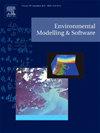Predicting climate change: A comparative analysis of time series models for CO2 concentrations and temperature anomalies
IF 4.6
2区 环境科学与生态学
Q1 COMPUTER SCIENCE, INTERDISCIPLINARY APPLICATIONS
引用次数: 0
Abstract
This study presents a novel, integrated modeling framework that combines machine learning (ML) techniques with physics-based approaches to forecast both CO2 emissions and global temperature anomalies. Unlike prior research that typically addresses these components in isolation, this work concurrently applies and compares five advanced ML models—Long Short-Term Memory (LSTM), Extreme Gradient Boosting (XGBoost), Convolutional Neural Network (CNN), Facebook Prophet, and a hybrid CNN-LSTM—alongside two physics-based models: a zero-dimensional Energy Balance Model (EBM) and a simplified General Circulation Model (GCM) adapted from NASA's GISS framework.Using monthly global datasets from January 2000 to April 2024, obtained from the National Oceanic and Atmospheric Administration (NOAA) and the Scripps Institution of Oceanography, the models are evaluated based on predictive accuracy (RMSE, MSE, MAE, R2), scalability, and interpretability. Prophet demonstrated the highest accuracy for CO2 emission forecasting (RMSE = 0.035), while LSTM achieved the best performance in temperature anomaly prediction (RMSE = 0.086). Physics-based models provided interpretable and computationally efficient long-term projections but lacked short-term flexibility.To facilitate reproducibility and practical application, we developed ClimateChange-ML, an open-source software package that implements all proposed models, includes trained weights, and provides full documentation and visualization tools.The novelty of this work lies in its dual-modeling strategy and comprehensive comparative evaluation, highlighting the complementary strengths of data-driven and physically grounded methods. This integrated approach offers a more holistic framework for climate forecasting across multiple temporal scales, providing valuable insights for both scientific understanding and climate policy planning.
预测气候变化:CO2浓度和温度异常的时间序列模式的比较分析
本研究提出了一种新颖的集成建模框架,将机器学习(ML)技术与基于物理的方法相结合,用于预测二氧化碳排放和全球温度异常。与之前的研究不同,这些研究通常是孤立地解决这些组件,这项工作同时应用并比较了五种先进的机器学习模型——长短期记忆(LSTM)、极端梯度增强(XGBoost)、卷积神经网络(CNN)、Facebook Prophet和CNN-LSTM的混合模型——以及两种基于物理的模型:零维能量平衡模型(EBM)和简化的一般循环模型(GCM),这些模型来自NASA的GISS框架。利用美国国家海洋和大气管理局(NOAA)和斯克里普斯海洋研究所2000年1月至2024年4月的月度全球数据集,基于预测精度(RMSE、MSE、MAE、R2)、可扩展性和可解释性对这些模式进行了评估。Prophet对CO2排放的预测精度最高(RMSE = 0.035),而LSTM对温度异常的预测精度最高(RMSE = 0.086)。基于物理的模型提供了可解释和计算效率高的长期预测,但缺乏短期灵活性。为了促进再现性和实际应用,我们开发了一个开源软件包ClimateChange-ML,它实现了所有提出的模型,包括训练过的权重,并提供了完整的文档和可视化工具。本研究的新颖之处在于双建模策略和综合比较评价,突出了数据驱动和物理基础方法的互补优势。这种综合方法为跨多个时间尺度的气候预报提供了一个更全面的框架,为科学理解和气候政策规划提供了有价值的见解。
本文章由计算机程序翻译,如有差异,请以英文原文为准。
求助全文
约1分钟内获得全文
求助全文
来源期刊

Environmental Modelling & Software
工程技术-工程:环境
CiteScore
9.30
自引率
8.20%
发文量
241
审稿时长
60 days
期刊介绍:
Environmental Modelling & Software publishes contributions, in the form of research articles, reviews and short communications, on recent advances in environmental modelling and/or software. The aim is to improve our capacity to represent, understand, predict or manage the behaviour of environmental systems at all practical scales, and to communicate those improvements to a wide scientific and professional audience.
 求助内容:
求助内容: 应助结果提醒方式:
应助结果提醒方式:


